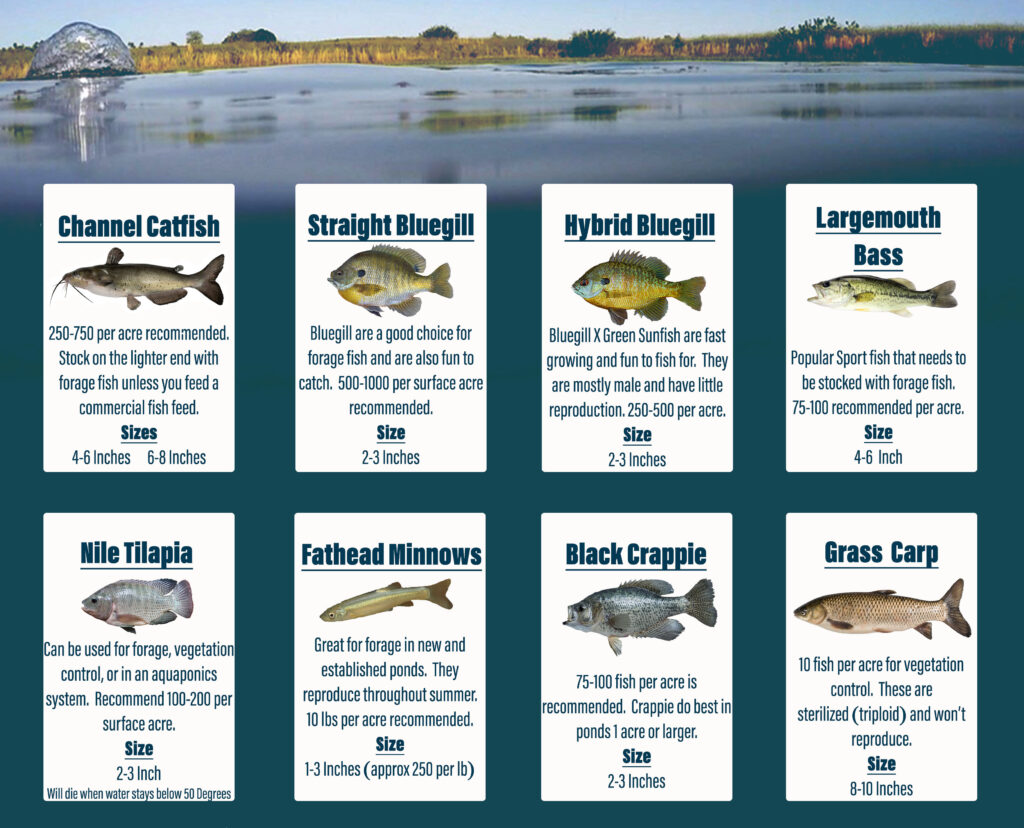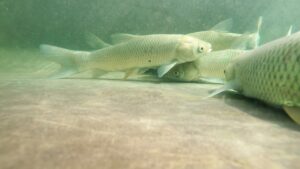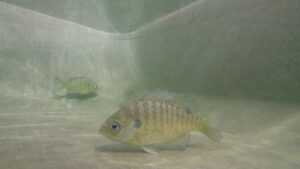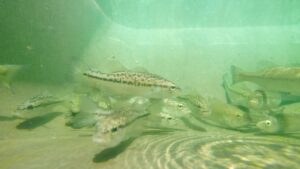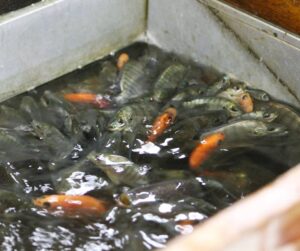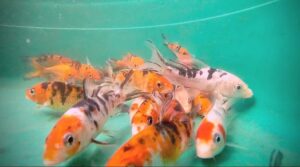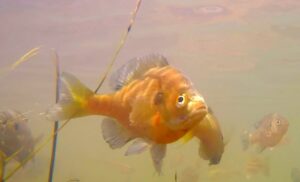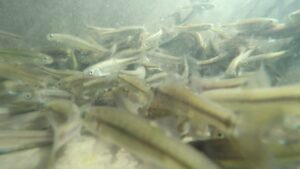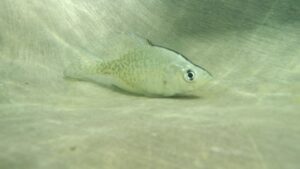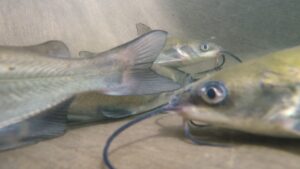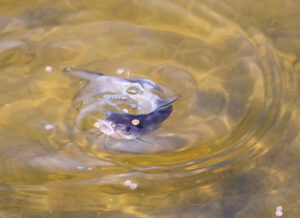Fish Species (Scroll Down for FAQ and Sample Stocking Rates)
Click on the Videos for more Information
10 videos found
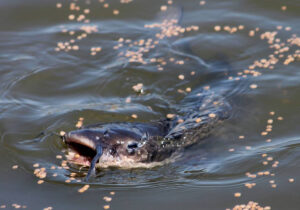
Frequently Asked Questions
- What should I stock in my pond? We are asked this question a lot and there isn’t one size fits all answer. The answer depends on your fishing goals and budget. We can work with you to help you decide what will work best in your pond. Each pond is different and therefore needs an individual plan. Below are some stocking examples, but keep in mind there can be many variations. Give us a call or email us if you want personalized help.
- What is the difference in Bluegill and Hybrid Bluegill? Straight Bluegill are a native fish to the area. They are about evenly male and female and reproduce during the Summer months, making them ideal for forage fish. The Hybrid Bluegill are a cross between the Straight Bluegill and a Green Sunfish. They are around 90% male and don’t have good reproduction. They are both good for kids fishing although the Hybrids are more aggressive about biting the hook and a little hardier when being handled.
- What do I need to bring to pick up my fish? Visit our page about it here. We recommend checking with us before heading out to double check on what you need for pick up, but generally we can bag most of the fish in a plastic bag with oxygen. The catfish fingerlings poke holes in the bag so it’s best to bring a container to put them in. We will fill the container with water here at the farm. The larger fish will also need to be hauled in a container. We recommend things like a 55 gallon trash can, large ice chest, large storage container, etc.
- Do you deliver or run a route truck? We don’t run a route truck but we do offer delivery all over the state and to surrounding areas. We like to bring the fish directly from our farm to your pond so they don’t spend much time in tanks. We charge $3.00 per loaded mile for delivery. There is a $500 minimum for delivery. Some smaller orders can be combined with others the same area if possible.
- Why don’t you sell Coppernose Bluegill? We don’t recommend Coppernose Bluegill for our area because there can be a high mortality rate if the pond ices over. If you are in Southern Oklahoma we can source them if you want to stock Coppernose. Otherwise, we recommend Straight Bluegill and minnows for forage fish in your pond.
- Should I feed my fish? The answer depends on your pond goals. Feeding a floating pellet will allow faster growth and take pressure off of the forage fish, or can altogether eliminate the need to stock forage fish. If feeding is not something you are interested in or isn’t feasible don’t worry! Stocking forage fish will allow the pond to be properly managed without the need for supplemental feeding.
- What and how much should I feed my fish? We recommend feeding what the fish will consume in about 10 minutes time. If you feed more than that it can cause water quality problems and is just wasting the fish feed. After stocking new fish in a pond it can take a couple of weeks or more for the new fish to catch on. You will have better success if you feed in the same place around the same time each day. Feeding can be a fun and enjoyable time for adults and children, and will also keep the fish growing.
- Should I stock Tilapia or Grass Carp to get rid of vegetation? Both types of fish are a good choice for vegetation control. They are completely different in the way they source food but they both eat aquatic nuisance weeds. The Grass Carp are better for the rooted types of vegetation. We recommend 10 fish per surface acre unless the problem is severe, and then more may be needed. The Grass Carp are sterilized and will not reproduce in your pond. Tilapia love duckweed and filamentous types of algae. They eat vegetation and also reproduce quickly giving your other fish a nice forage base, giving you two good reasons to stock them! The downside to stocking Tilapia is that they die when the water temperatures get too cold, usually around Thanksgiving in this area. They have to be restocked each year but many of our customers make this a regular purchase to keep their ponds healthy. The good news with both of these fish is that they will not overtake your pond and either one is a good chemical free option.
- How can I safely release my fish? Acclimating fish to the temperature of your pond is important. Most of the time the water in our fish house is very similar to the water in your pond. When you take home your oxygenated bags of fish we recommend floating them for a 5-10 minutes before releasing them.
- How many acres is my pond? Knowing the size of your pond is important when stocking fish. PennState has a good article here about calculating pond size and Kasco marine has a calculator that can be accessed here.
- What Type Of Fish Do I Raise for Food?
- We are getting a lot of questions about what to stock so you have access to fresh fish if you want or need it. Here are a few of our thoughts based on our experience with raising fish.
- In our opinion the best bang for your are the Channel Catfish. They are cheaper to buy and they grow faster with less input than other species. However, they are not ideal for every situation. We’ll get into that below.
- One of the first things to consider is what space you have for the fish. Is it a new pond, existing pond, or a backyard set-up? The approach to stock these will be a little different for each.
- If you have an existing pond, what type of fish are in it? If you have larger fish already, you many consider adding forage to keep the larger, eating size fish healthy and growing. Or you may want to add larger sized catfish so they have a less chance of being eaten by the other fish.
- If you have a newly constructed pond you have some options. What are your goals? If it’s for food you can add forage fish such as minnows and bluegill to naturally feed your Catfish. We recommend starting with a 6-8″ Catfish. If fed properly they will range from 3/4 lb to 1 lb by Fall. If you don’t want catfish you can add largemouth bass. The 4-6″ size if fed properly will be around 3/4 lb by the end of the growing season. Crappie are an option but just do not grow as fast. It takes a while to get them to eating size.
- If you have a backyard aquaponics set-up or a tank then you will have different conditions for the fish to grow. Catfish can be put in these systems but being packed closely can cause them to be more susceptible to conditions like ich and fungus. Tilapia usually work best in these tanks. We have fingerlings available now but will try and keep some available through the Summer to stock. Tilapia have to have water above 60 degrees to live, although they thrive in water above 80 degrees. That is a limitation to growing these fish, but make them a good option for the warmer months. Some information states that Tilapia fingerlings grow to 1 lb size in 180 days but in our experience it is a little longer. During the colder months Catfish or Hybrid Bluegill make the next best options in our opinion.
- Tilapia can be stocked in an earthen pond but can be harder to get back out before they start to die when the water gets cold in the early Winter months. People have had luck catching them on the side of the pond as they get cold and slow down. Some also catch them on a rod and reel but they tend to be harder to catch than other species.
- What do I feed & How much? We recommend feeding a floating feed specific for fish. It is similar in look to other feeds but it is made differently. Most farm stores carry a fish feed that will do just fine for growing your fish. We feed Cargill fish feed. We have a “10 Minute” general rule when feeding our fish. What they will consume in around 10 minutes is usually adequate for growing and doesn’t create waste which lowers the water quality and can cause die-offs. Two to Three times a week is enough to keep the fish growing at a good pace, but you can feed them daily. For best results pick the same place on the pond bank and approximately the same time of day to feed. It will take them a couple of weeks to get used to coming up to eat but once they figure it out they will be waiting for you!
- Obstacles you might face. Water quality is one problem that you might have. If you don’t stock super heavy most of the time you can avoid these issues. High levels of vegetation can cause low oxygen of a morning because the plants remove it from the water at night. Over feeding can contribute to water quality problems. Following the “10 Minute” rule suggested above will help avoid this. Certain chemicals used for lawns can be toxic to fish so consider the run off when applying chemicals.
- Otters, Birds, Snakes, Turtles in that order! These are the predators that can eat the most fish. The river otters have really increased in population the last few years. They have eaten thousands of dollars worth of fish here at the farm the last couple of years. You will notice signs of them such as slides on the pond dam as well as scat filled with scales. They can wipe out a fish population very quickly in ponds. Lately we have had several customers that didn’t know where there fish had went (some even blamed the neighbors) but it ended up being otters. They are hard to detect sometimes. Fish eating birds are noticed much easier than otters and can usually be scared away pretty quickly. The common water snakes can eat fish as well as some species of turtles. The otters and birds will be a bigger threat to your fish though.
- The bottom line is with a little effort & planning you can easily build your fresh fish supply. Hopefully these have been some helpful things to consider. Let us know if you have anymore questions!
Pond Stocking Rates
These are some of our basic sizes and species. Please contact us to create a personalized plan for your pond!
